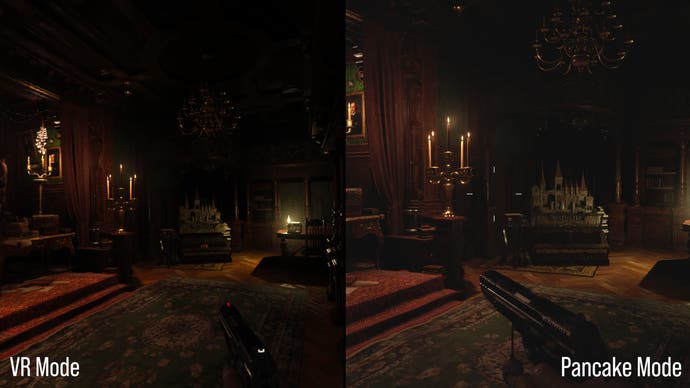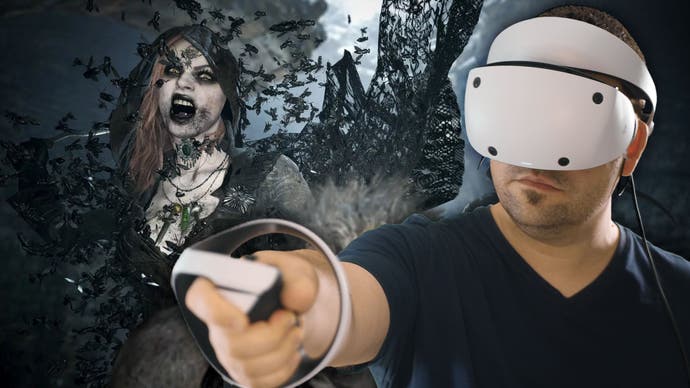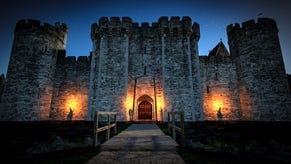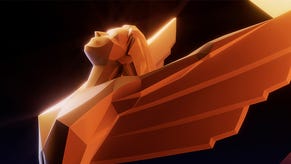Resident Evil Village PSVR2 tech review: superb visuals, game-changing controls
It feels like RE Village was developed with VR in mind.
Resident Evil 7 is one of the best titles for the original PSVR with the extra immersion provided by the headset elevating the experience to a new level - despite using the same DualShock 4 controls as the standard game. Now we have PSVR2 support for Resident Evil Village and this time Capcom has embraced the new Sense controllers, fundamentally altering the core gameplay. So how do the visuals hold up in VR and what sacrifices were necessary to get there - and how do the new Sense controls influence the experience?
VR support in RE Village is accessed via a downloadable patch and once installed you're prompted to choose between 2D and VR when booting the game. This is a straightforward way to handle VR but this does mean that the VR mode features its own saves and lacks trophy support. The game's intro plays in a floating virtual screen but the game transitions to a full stereoscopic 3D thereafter - including cutscenes. This is cool, but these sequences' pre-defined camera movement and animation could trigger motion sickness in some users, but the good news is that a more settling alternative is available, as you can opt to view the cutscenes within a floating screen if you prefer.
Once gameplay begins proper, it's clear that Village looks a little different than it does on a 2D screen. Ray tracing isn't present here, understandably, and the game seems to run at 60fps rather than the 90fps or 120fps achieved by less visually-demanding PSVR2 titles. However, your head movement tracked at 120Hz with asynchronous time warp, so the experience still feels reasonably fluid.
Compared side-by-side to the 2D game, there's a hit to resolution - likely as a consequence of the wider field of view demanded by the VR presentation. This is mostly masked by the game's eye-tracked foveated rendering; essentially the game renders at much higher resolution wherever you're looking, cutting resolution elsewhere to compensate. This works brilliantly and feels impossible to fake out, making the game vastly sharper than Resident Evil 7 is on the original PSVR. This rosy outlook is dampened somewhat by the presence of extremely noticeable specular aliasing in certain scenes, which creates shimmering and flicking on bright edges. You may also notice the game's reliance on cube maps for reflections, which are more obviously unrealisic in 3D thanks to the system lacking any depth of parallax.
Despite the loss in image quality and these few visual phenomena, the overall rendered visual fidelity is retained, and the game looks just as good as you remember. The environments are beautifully detailed and a delight to explore in full VR. I've often found that VR is most immersive when dealing with smaller spaces and Village has plenty of them.
The translation of the visuals to VR is certainly interesting as well - Lady Dimitrescu was always an imposing figure in the standard game but her presence is downright disturbing in VR as she's absolutely gigantic. I always felt that characters in RE7's VR mode were scaled strangely, appearing almost inhumanly small, but that's definitely not the case here.

The headset's ability to handle deeper contrast courtesy of its OLED panel pays off big time - especially in darker scenes which now appear truly black and walking around beneath the castle is particularly tense in VR. The presentation isn't quite perfect though, as I noticed some underlying image grain in the OLED panel. This was more obvious in RE Village than other games I've tested but honestly PSVR2 is still far better than other VR headsets I've tested in terms of displaying rich black levels.
Beyond the new headset, the experience of playing RE Village is upended by the Sense controllers and the new interface built around them. Each Sense controller acts as one hand, with the capacitive surfaces on the controllers determining the position of your fingers in the game world. Compared to the non-VR mode - which uses simple button presses to select items and weapons - Village VR instead integrates these features onto your virtual self. The knife, for instance, rests in a sheath attached to your left arm - you simply hold up your arm and grab the knife to use it.
There are several options related to holding items too. By default, the hybrid mode requires you to hold the grip button to retain items in your hand - this means, if you lose your grip, you drop whatever you were holding. The solution to this problem is clever, though - once you drop an item, it respawns in its original position so you're not constantly kneeling down to pick-up dropped weapons. This has interesting side effects too - you can now throw knives, breaking objects and injuring enemies in the process. That alone feels great, but due to the item respawn system, you basically have infinite throwing knives in VR. This doesn't do enough damage to enemies to ruin the game balance, and it's a fun addition.
.png?width=690&quality=75&format=jpg&auto=webp)
Other weapons are virtually mounted across your invisible torso - your pistol rests at waist height by default, so you simply reach down, hold the grip button and now the pistol is in your hand. Each weapon requires actual manipulation to reload too - on the pistol, you tap the circle button to eject the magazine, then reach down to your pouch for a new one, jam it into the pistol then pull the slide mechanism. With the shotgun, you need to insert each shell one at a time and after each shot you need to rack the action of the shotgun to eject used shell casings. It feels pretty great.
What really elevates this is the extra tension added to combat - when battling a foe, reloading your weapon now requires far more finesse, completely changing the experience. There are accessibility options available if you don't want to engage with these systems, but I think it adds a lot to the immersion.
Other items include the flashlight and first-aid potions. To access these, simply pull open your virtual jacket with one hand and grab the item with the opposite hand. In the case of the flashlight, it even has three separate modes of use - you can toggle the position of your grip or attach it directly to your body, like RE7 in VR. Holding a flashlight in one hand and a weapon in the other feels great, that's for sure.
All of these features wind up feeling comparable to dedicated VR experiences like Half-Life Alyx - the only thing really lacking here are incidental physics interactions. Aside from a handful of specific environmental objects, most items within the world do not react to your hands. You can't pick up random bottles or objects in Village, lessening the immersion slightly. That said, Capcom did rework certain puzzles to use hand tracking - eg letting you push a fiery brazier to light torches. You also directly interact with inventory items such as keys when unlocking doors or open drawers. Heck, the entire inventory and shop system has been modified and is now presented in full 3D with the controllers behaving as 3D pointers. It feels great.
Capcom includes a bunch of other adjustments that you'd expect in a VR game such as speed, type and degree of turning but, even still, this is an intense game in VR. If you're prone to motion sickness, it may trigger some queasiness, even on the gentlest of settings.
Speaking of VR settings, I want to mention another option directly related to the PSVR2 headset itself - specifically, the brightness setting accessible from the PS5 OS. For most games, I've been using the headset at maximum brightness, which slightly increases the prevalence of persistence blur so turning it down a few notches can improve motion clarity. In RE Village however, I'd suggest turning the brightness to the minimum setting. This does crush shadow detail in some scenes, but you get a much darker, creepier game in exchange - the flashlight becomes vital as darker corridors are now bathed in shadow. I think it's worth a try, so give it a few minutes and see if it grabs you - for me, I couldn't go back to the standard setting.
Finally, it's worth mentioning the audio element. RE Village makes incredible use of spatial audio - as you'd hope from a horror game. If you try standing near an object creating noise and closing your eyes, you should be able to pinpoint the exact location of said object by sound alone. It's that effective. This feature greatly improves immersion, and being chased by an enemy becomes far more frightening.
Ultimately, I think Capcom has done an exceptional job with this update with just a few caveats. The visual side of things is extremely faithful to the graphics viewed on a normal TV screen, with a small hit to image quality but a generational leap forward compared to RE7 on PSVR1. The clarity and sense of place is seriously engaging. Everything feels far more grandiose and immersive, making it a fantastic way to either revisit the game or play it for the first time. The headset certainly helps a lot in its own right - the improved comfort and superior head tracking make for a more comfortable and enjoyable experience.
For me though, it's the Sense controllers that steal the show. The addition of full hand tracking is a true game-changer that PSVR1 owners never really got to experience. I was surprised at how well integrated this VR mode truly is. Aside from lack of physics-driven objects, this feels like a game that was built with VR in mind - and heck, maybe it was!
The most promising aspect is the fact that a standard game like this can feature such a robust VR mode. I don't expect tol see too many high budget PSVR2-only games, owing to the peripheral's smaller market share, but if developers can produce VR iterations of their games at this level of quality then I think PSVR2 becomes much more compelling.











